Edible Shrubs
Español 
There are a great many ornamental shrubs and small trees with edible fruits, leaves etc that can often be seen growing in ornamental gardens. Below is a list of just a few suggestions for you to consider growing. The main difficulty in writing this leaflet was not so much what plants to include, but what plants could be left out in order to reduce the list to a reasonable length. Other leaflets are available giving details of plants that can be grown in the ornamental, water and bog gardens, but if you have any plants in your garden that have not been included on any lists and that you think might be edible or have other useful qualities, then you could always write to us giving details of the plant including the botanical name (if you know it), the common name and a brief description (ie tree/shrub/herbaceous perennial etc, evergreen/deciduous, height etc, etc).
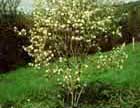 Amelanchier species: Juneberries produce blackcurrant-size juicy fruits in July (which is why we call them juneberries!). If you can get there before the birds you will find that the fruits have a pleasant apple- like taste. The main problem is that birds like the fruits so much they will often eat them under-ripe and will not leave many for you to try. The plants are exceedingly beautiful when they flower in early to mid spring. All members of this genus produce edible fruits, though some are not very desireable, and plants range in size from small shrubs to tall trees. Our favourite is A. alnifolia, it grows about 2 metres tall and produces suckers. The fruit, which is very juicy and relatively large, can be protected from the birds relatively easily because of the small size of the plants. Others that we also like include A. canadensis, a suckering tree growing about 6 metres tall that has become naturalized in Britain and A. lamarckii which is about 6 metres tall - this species does not sucker. There is also a cultivar A. 'Ballerina' that is often found in garden centres, this plant has larger than average fruits with a pleasant sweet taste.
Amelanchier species: Juneberries produce blackcurrant-size juicy fruits in July (which is why we call them juneberries!). If you can get there before the birds you will find that the fruits have a pleasant apple- like taste. The main problem is that birds like the fruits so much they will often eat them under-ripe and will not leave many for you to try. The plants are exceedingly beautiful when they flower in early to mid spring. All members of this genus produce edible fruits, though some are not very desireable, and plants range in size from small shrubs to tall trees. Our favourite is A. alnifolia, it grows about 2 metres tall and produces suckers. The fruit, which is very juicy and relatively large, can be protected from the birds relatively easily because of the small size of the plants. Others that we also like include A. canadensis, a suckering tree growing about 6 metres tall that has become naturalized in Britain and A. lamarckii which is about 6 metres tall - this species does not sucker. There is also a cultivar A. 'Ballerina' that is often found in garden centres, this plant has larger than average fruits with a pleasant sweet taste.
.jpg) Arbutus unedo - Strawberry Tree: An evergreen tree that can grow up to 30 feet tall, but there are smaller growing varieties. One that has been particularly recommended is 'Croome', which is said to fruit more freely and has an attractive red tinge to the flowers. The tree succeeds on most soils and produces edible fruits in late autumn. It is particularly beautiful at this time because it is also in flower. Whilst not highly flavoured, the fruits have a nice, subtle taste. (See our leaflet on Arbutus unedo for more information about this plant).
Arbutus unedo - Strawberry Tree: An evergreen tree that can grow up to 30 feet tall, but there are smaller growing varieties. One that has been particularly recommended is 'Croome', which is said to fruit more freely and has an attractive red tinge to the flowers. The tree succeeds on most soils and produces edible fruits in late autumn. It is particularly beautiful at this time because it is also in flower. Whilst not highly flavoured, the fruits have a nice, subtle taste. (See our leaflet on Arbutus unedo for more information about this plant).
.jpg) Arundinaria species and Phylostachys species - Bamboos: Evergreen grasses that make very attractive specimen plants in lawns and can also be used as screens. Many species have edible shoots in spring and their canes make good plant supports.
Arundinaria species and Phylostachys species - Bamboos: Evergreen grasses that make very attractive specimen plants in lawns and can also be used as screens. Many species have edible shoots in spring and their canes make good plant supports.
.jpg) Berberis species - Barberries: This genus includes some extremely ornamental evergreen and deciduous shrubs and they tend to tolerate most soils and locations. None of them have poisonous fruits though many of them are unpalatable. B. vulgaris was once quite commonly grown in the fruit garden but has fallen out of favour in recent times. This plant is also the alternate host of the black stem rust of wheat, so it has virtually been eradicated from our hedgerows and woodlands by farmers. Other species to consider include B. aggregata, B. angulosa, B. aristata, B. asiatica, B. buxifolia, B. darwinii and B. lycium. The fruits are acid but can be eaten raw (best after a frost) or used to make conserves, jams etc. They can also be dried and used as a substitute for raisins. Some species can be used to make very ornamental informal hedges (B. darwinii is especially good).
Berberis species - Barberries: This genus includes some extremely ornamental evergreen and deciduous shrubs and they tend to tolerate most soils and locations. None of them have poisonous fruits though many of them are unpalatable. B. vulgaris was once quite commonly grown in the fruit garden but has fallen out of favour in recent times. This plant is also the alternate host of the black stem rust of wheat, so it has virtually been eradicated from our hedgerows and woodlands by farmers. Other species to consider include B. aggregata, B. angulosa, B. aristata, B. asiatica, B. buxifolia, B. darwinii and B. lycium. The fruits are acid but can be eaten raw (best after a frost) or used to make conserves, jams etc. They can also be dried and used as a substitute for raisins. Some species can be used to make very ornamental informal hedges (B. darwinii is especially good).
 Chaenomeles species - Quinces: Not the true quince, which is Cydonia oblonga, but the fruits of these deciduous shrubs are so similar that you would hardly notice the difference. They vary in size from about 2 feet to 15 feet and, for best fruit production, should be grown in a sunny position, though they are not really fussy. Harsh and astringent raw, the cooked fruit becomes very aromatic and can be added to other cooked fruit (especially apples) or used to make jams, jellies etc.
Chaenomeles species - Quinces: Not the true quince, which is Cydonia oblonga, but the fruits of these deciduous shrubs are so similar that you would hardly notice the difference. They vary in size from about 2 feet to 15 feet and, for best fruit production, should be grown in a sunny position, though they are not really fussy. Harsh and astringent raw, the cooked fruit becomes very aromatic and can be added to other cooked fruit (especially apples) or used to make jams, jellies etc.
 Comptonia peregrina asplenifolia - Sweet Fern: Not a fern, but a beautiful deciduous shrub about four feet tall with fern-like leaves. It requires a lime-free soil and, in its natural habitat, grows on poor, dry, sandy soils, so it won't need much feeding. The fruits may be eaten raw, the dried leaves make a refreshing tea, and the fresh leaves are used as a lining in fruit baskets to help preserve the fruits.
Comptonia peregrina asplenifolia - Sweet Fern: Not a fern, but a beautiful deciduous shrub about four feet tall with fern-like leaves. It requires a lime-free soil and, in its natural habitat, grows on poor, dry, sandy soils, so it won't need much feeding. The fruits may be eaten raw, the dried leaves make a refreshing tea, and the fresh leaves are used as a lining in fruit baskets to help preserve the fruits.
 Cornus mas - Cornelian Cherry: A deciduous shrub, up to 20 feet tall, but can be kept smaller in cultivation. Formerly cultivated for its fruit, it is now often found in the ornamental garden where it is valued for its early spring flowers. It prefers a chalky soil but tolerates most soils and fruits best when in a sunny position. The fruit can be eaten raw, an edible oil can be extracted from the seeds, and the wood, which is very tough, is much valued for making tools, cogs etc. Crataegus species. This genus includes our native hawthorns (see our leaflet on hedge plants for details of these). All members of the genus have edible fruits but, whilst the fruit of a hawthorn is edible, it is far from being appetizing. However there are several members of the genus that have absolutely delicious fruits and I would highly recommend them as a fruit crop. The trees are very easy to grow, they tolerate most soils and situations including drought and occasional waterlogging. They are very ornamental when flowering in the spring and also when in fruit. Most species fruit abundantly in Britain. Our two special favourites are C. arnoldiana and C. schraderiana. Their fruits are about the size of a large cherry and usually have a group of five seeds in the centre. These seeds stick together and so the effect is of eating a fruit with one large seed. The soft juicy flesh is very well flavoured, and can be eaten in quantity. I would certainly prefer a bowl of these to a bowl of strawberries. Other members of this genus that also have very nice fruits include C. azarolus (the azerole is sometimes cultivated in the Mediterranean but I have not yet tried it), C. douglasii, C. durobrivensis, C. ellwangeriana, C. opaca and C. tanacetifolia. This last species has a much firmer flesh and is decidedly apple-like in its flavour.
Cornus mas - Cornelian Cherry: A deciduous shrub, up to 20 feet tall, but can be kept smaller in cultivation. Formerly cultivated for its fruit, it is now often found in the ornamental garden where it is valued for its early spring flowers. It prefers a chalky soil but tolerates most soils and fruits best when in a sunny position. The fruit can be eaten raw, an edible oil can be extracted from the seeds, and the wood, which is very tough, is much valued for making tools, cogs etc. Crataegus species. This genus includes our native hawthorns (see our leaflet on hedge plants for details of these). All members of the genus have edible fruits but, whilst the fruit of a hawthorn is edible, it is far from being appetizing. However there are several members of the genus that have absolutely delicious fruits and I would highly recommend them as a fruit crop. The trees are very easy to grow, they tolerate most soils and situations including drought and occasional waterlogging. They are very ornamental when flowering in the spring and also when in fruit. Most species fruit abundantly in Britain. Our two special favourites are C. arnoldiana and C. schraderiana. Their fruits are about the size of a large cherry and usually have a group of five seeds in the centre. These seeds stick together and so the effect is of eating a fruit with one large seed. The soft juicy flesh is very well flavoured, and can be eaten in quantity. I would certainly prefer a bowl of these to a bowl of strawberries. Other members of this genus that also have very nice fruits include C. azarolus (the azerole is sometimes cultivated in the Mediterranean but I have not yet tried it), C. douglasii, C. durobrivensis, C. ellwangeriana, C. opaca and C. tanacetifolia. This last species has a much firmer flesh and is decidedly apple-like in its flavour.
.jpg) Elaeagnus species: Many of the species in this genus have quite pleasant tasting fruit and they are often cultivated, particularly in the Orient, for their fruit which is used to make drinks and sherbet. This is another group of shrubs that are not too fussy about soil conditions though they tend to fruit better when grown in a sunny position in light soil that is not too rich, and many of them can be grown as an informal hedge. Species to consider include E. angustifolia, E. commutata, E. x. ebbingei, E. glabra, E. macrophylla, E. multiflora and E. pungens, which is said to be the best of the genus.
Elaeagnus species: Many of the species in this genus have quite pleasant tasting fruit and they are often cultivated, particularly in the Orient, for their fruit which is used to make drinks and sherbet. This is another group of shrubs that are not too fussy about soil conditions though they tend to fruit better when grown in a sunny position in light soil that is not too rich, and many of them can be grown as an informal hedge. Species to consider include E. angustifolia, E. commutata, E. x. ebbingei, E. glabra, E. macrophylla, E. multiflora and E. pungens, which is said to be the best of the genus.
.jpg) Diospyros lotus and D. virginiana: These two trees produce some of the most delicious fruits we have ever eaten from plants growing in Britain. They are related to the persimmon or sharon fruit that is sometimes seen in greengrocers and are very similar in shape but smaller, ranging in size from a large cherry to a small crab apple. Only eat the fruit when it is absolutely ripe and squidgy soft, otherwise it will be astringent and have a rather unpleasant effect on your mouth. Fully ripe they taste like a rich apricot jelly. Plants do require a good summer in order to ripen the fruit properly so they grow better in the southeast. The fruit is also nicer after a frost, allow the fruit to fall naturally from the tree and leave it on the ground (if the birds etc don't start eating it) until there is a frost or two. Then harvest the fruit and store it in a cool place until it is really soft, in fact almost at the point of going rotten. D. lotus is sometimes called the date plum and can grow to about 9 metres tall, D. virginiana is the American persimmon and can be much taller, it has also been the best cropper in my experience and is possibly the best flavoured. Named forms of this plant are available in America.
Diospyros lotus and D. virginiana: These two trees produce some of the most delicious fruits we have ever eaten from plants growing in Britain. They are related to the persimmon or sharon fruit that is sometimes seen in greengrocers and are very similar in shape but smaller, ranging in size from a large cherry to a small crab apple. Only eat the fruit when it is absolutely ripe and squidgy soft, otherwise it will be astringent and have a rather unpleasant effect on your mouth. Fully ripe they taste like a rich apricot jelly. Plants do require a good summer in order to ripen the fruit properly so they grow better in the southeast. The fruit is also nicer after a frost, allow the fruit to fall naturally from the tree and leave it on the ground (if the birds etc don't start eating it) until there is a frost or two. Then harvest the fruit and store it in a cool place until it is really soft, in fact almost at the point of going rotten. D. lotus is sometimes called the date plum and can grow to about 9 metres tall, D. virginiana is the American persimmon and can be much taller, it has also been the best cropper in my experience and is possibly the best flavoured. Named forms of this plant are available in America.
.jpg)
 Gaultheria species - Wintergreen: Evergreen shrubs requiring a lime-free soil and some shade. They vary in height from a few inches to five feet, all of them having edible fruits. Two species quite commonly grown in Britain are G. procumbens, about six inches tall, and G. shallon which grows up to four feet. The fruit is highly aromatic with a flavour that is somehow reminiscent of a hospital waiting room! Some people love them, others are a bit less sure. The leaves can be used to make a refreshing tea, and an oil distilled from these plants (oil of wintergreen) is often used as a liniment in the treatment of muscular aches and pains.
Gaultheria species - Wintergreen: Evergreen shrubs requiring a lime-free soil and some shade. They vary in height from a few inches to five feet, all of them having edible fruits. Two species quite commonly grown in Britain are G. procumbens, about six inches tall, and G. shallon which grows up to four feet. The fruit is highly aromatic with a flavour that is somehow reminiscent of a hospital waiting room! Some people love them, others are a bit less sure. The leaves can be used to make a refreshing tea, and an oil distilled from these plants (oil of wintergreen) is often used as a liniment in the treatment of muscular aches and pains.
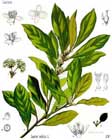 Laurus nobilis - Bay Tree: An evergreen shrub or small tree, the leaves of which are used as a food flavouring. Only reliably hardy in the mild parts of Britain, this tree is very amenable to pot culture so can be kept in a sheltered position over winter and moved into the garden during the warmer months. It tolerates clipping so is often grown as an ornamental plant.
Laurus nobilis - Bay Tree: An evergreen shrub or small tree, the leaves of which are used as a food flavouring. Only reliably hardy in the mild parts of Britain, this tree is very amenable to pot culture so can be kept in a sheltered position over winter and moved into the garden during the warmer months. It tolerates clipping so is often grown as an ornamental plant.
.jpg) Mahonia aquifolium - Oregon Grape: An evergreen shrub growing about four feet tall, this really is one of the most tolerant of plants, succeeding in most situations, even dense shade, and surviving almost total neglect. Fruit production will be greatly improved, though, if you give it just a little bit of attention. The fruit is acid and can be eaten raw (best after a frost) or used in jams, preserves etc. All other members of this genus have edible fruits.
Mahonia aquifolium - Oregon Grape: An evergreen shrub growing about four feet tall, this really is one of the most tolerant of plants, succeeding in most situations, even dense shade, and surviving almost total neglect. Fruit production will be greatly improved, though, if you give it just a little bit of attention. The fruit is acid and can be eaten raw (best after a frost) or used in jams, preserves etc. All other members of this genus have edible fruits.
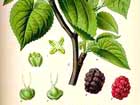 Morus nigra - Mulberry: A slow growing, very long lived, deciduous tree eventually reaching 30 feet in height. It makes a fine specimen tree in the lawn, and does better in the southern half of the country, preferring a light soil in a moist, well sheltered, sunny position. The fruit, looking somewhat like a large blackberry, ripens intermittently over a period of about four weeks towards the end of summer and, when fully ripe, is delicious but best eaten immediately because it is easily squashed. The mulberry tree is said to make a very good companion for a grape vine. The vine is allowed to grow into the tree, giving two fruit crops for the space of one.
Morus nigra - Mulberry: A slow growing, very long lived, deciduous tree eventually reaching 30 feet in height. It makes a fine specimen tree in the lawn, and does better in the southern half of the country, preferring a light soil in a moist, well sheltered, sunny position. The fruit, looking somewhat like a large blackberry, ripens intermittently over a period of about four weeks towards the end of summer and, when fully ripe, is delicious but best eaten immediately because it is easily squashed. The mulberry tree is said to make a very good companion for a grape vine. The vine is allowed to grow into the tree, giving two fruit crops for the space of one.
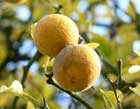 Poncirus trifoliata: A deciduous shrub growing up to six feet tall, this is the only fruit-bearing shrub of the orange family that is genuinely hardy in Britain. The fruit, unfortunately, is inedible raw, though it can be used in conserves etc. This shrub is very sparsely leaved, much of the photosynthesis taking place in the young stems, but it has very large thorns which make it both attractive and a very effective barrier when grown as a hedge. It fruits best in a sunny position. A hybrid between this plant and the orange, called a 'Citrange', is hardy in south west England where it bears somewhat nicer fruits.
Poncirus trifoliata: A deciduous shrub growing up to six feet tall, this is the only fruit-bearing shrub of the orange family that is genuinely hardy in Britain. The fruit, unfortunately, is inedible raw, though it can be used in conserves etc. This shrub is very sparsely leaved, much of the photosynthesis taking place in the young stems, but it has very large thorns which make it both attractive and a very effective barrier when grown as a hedge. It fruits best in a sunny position. A hybrid between this plant and the orange, called a 'Citrange', is hardy in south west England where it bears somewhat nicer fruits.
 Prunus dulcis - Almond: A small deciduous tree that can be grown as a specimen tree in a lawn. It flowers very early in spring when it looks quite beautiful - unfortunately it doesn't often bear its edible nuts in this country. If two trees were grown to ensure cross-pollination and some protection given to the flowers during frosty weather, perhaps also resorting to hand pollination, then yields would probably be improved.
Prunus dulcis - Almond: A small deciduous tree that can be grown as a specimen tree in a lawn. It flowers very early in spring when it looks quite beautiful - unfortunately it doesn't often bear its edible nuts in this country. If two trees were grown to ensure cross-pollination and some protection given to the flowers during frosty weather, perhaps also resorting to hand pollination, then yields would probably be improved.
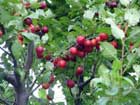 Prunus cerasifera - Cherry Plum: A deciduous shrub or small tree which can grow up to 30 feet so is really only suitable for larger gardens. It can be grown as a hedge with the bonus of providing a fruit which, as its name suggests, looks something like a cross between a cherry and a plum. It sometimes fruits abundantly but is often a disappointment. It does best in a sunny position in a well drained soil.
Prunus cerasifera - Cherry Plum: A deciduous shrub or small tree which can grow up to 30 feet so is really only suitable for larger gardens. It can be grown as a hedge with the bonus of providing a fruit which, as its name suggests, looks something like a cross between a cherry and a plum. It sometimes fruits abundantly but is often a disappointment. It does best in a sunny position in a well drained soil.
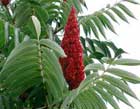 Rhus typhina - Stag's Horn Sumach: A deciduous shrub which can grow up to 20 feet tall, it is a striking sight in winter when its bare branches carry purple spikes of fruit at their tips. These spikes, when soaked for a short while in cold water, yield a very refreshing drink, used in America as a lemonade substitute. Other members of this genus with fruits that can be used similarly include R. aromatica and R. glabra. Some members of this genus are poisonous - they are easily distinguished by their fruits: the poisonous fruits are smooth whilst non-poisonous fruits hairy. These shrubs are dioecious (see note under Taxus baccata).
Rhus typhina - Stag's Horn Sumach: A deciduous shrub which can grow up to 20 feet tall, it is a striking sight in winter when its bare branches carry purple spikes of fruit at their tips. These spikes, when soaked for a short while in cold water, yield a very refreshing drink, used in America as a lemonade substitute. Other members of this genus with fruits that can be used similarly include R. aromatica and R. glabra. Some members of this genus are poisonous - they are easily distinguished by their fruits: the poisonous fruits are smooth whilst non-poisonous fruits hairy. These shrubs are dioecious (see note under Taxus baccata).
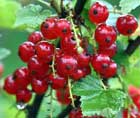 Ribes species - Currants and Gooseberries: Deciduous shrubs ranging in size from prostrate to 10 feet or more. As well as including our cultivated currants and gooseberries, this genus also has several ornamental species. They tend to be fairly tolerant of soil conditions but many of them require sunny positions in order to fruit satisfactorily. All members of this genus have edible fruits though many are not very desirable. Those worth trying include R. americanum, R. aureum, R. bracteosum, R. cereum, R. montigenum, R. niveum and R. rotundifolium.
Ribes species - Currants and Gooseberries: Deciduous shrubs ranging in size from prostrate to 10 feet or more. As well as including our cultivated currants and gooseberries, this genus also has several ornamental species. They tend to be fairly tolerant of soil conditions but many of them require sunny positions in order to fruit satisfactorily. All members of this genus have edible fruits though many are not very desirable. Those worth trying include R. americanum, R. aureum, R. bracteosum, R. cereum, R. montigenum, R. niveum and R. rotundifolium.
.jpg)
 Rosa species - Roses: These deciduous shrubs are widely grown in gardens. Their fruits are a good source of vitamin C, but often there is only a very thin layer of flesh and just below this there is a layer of irritating hairs which should not be eaten. Some species, however, have a much thicker layer of flesh and, indeed, some of them were formerly cultivated for their fruits. It is best to wait until the fruit is just going soft before picking it (usually after a frost) and then it is quite palatable raw - indeed, it can be sweet and delicious. The fruits can also be used to make conserves, jams etc and a vitamin C rich drink, the flower petals are eaten in some countries, an essential oil much used in perfumery can be extracted from the flowers, and the dried leaves are a tea substitute. Species worth trying include R. acicularis, R. canina (our native dog rose), R. rubiginosa and R. rugosa (both of which make very good flowering hedges), and R. villosa which is said to have the biggest fruit in this genus and which used to be cultivated as a fruit bush.
Rosa species - Roses: These deciduous shrubs are widely grown in gardens. Their fruits are a good source of vitamin C, but often there is only a very thin layer of flesh and just below this there is a layer of irritating hairs which should not be eaten. Some species, however, have a much thicker layer of flesh and, indeed, some of them were formerly cultivated for their fruits. It is best to wait until the fruit is just going soft before picking it (usually after a frost) and then it is quite palatable raw - indeed, it can be sweet and delicious. The fruits can also be used to make conserves, jams etc and a vitamin C rich drink, the flower petals are eaten in some countries, an essential oil much used in perfumery can be extracted from the flowers, and the dried leaves are a tea substitute. Species worth trying include R. acicularis, R. canina (our native dog rose), R. rubiginosa and R. rugosa (both of which make very good flowering hedges), and R. villosa which is said to have the biggest fruit in this genus and which used to be cultivated as a fruit bush.
.jpg)
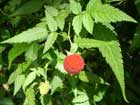 Rubus species: This genus of deciduous and evergreen shrubs, including our own raspberries and blackberries, includes several ornamental species with edible fruits. They prefer a moderately good loamy soil and species worth trying include R. amabilis, R. biflorus, R. laciniatus, R. odoratus (prefers semi-shade), R. parviflorus, R. phoenicolasius (the fruit of which develops within the calyx and is not, as far as we know, ever attacked by maggots), R. spectabilis and R. tricolor (a good ground cover plant for shady positions).
Rubus species: This genus of deciduous and evergreen shrubs, including our own raspberries and blackberries, includes several ornamental species with edible fruits. They prefer a moderately good loamy soil and species worth trying include R. amabilis, R. biflorus, R. laciniatus, R. odoratus (prefers semi-shade), R. parviflorus, R. phoenicolasius (the fruit of which develops within the calyx and is not, as far as we know, ever attacked by maggots), R. spectabilis and R. tricolor (a good ground cover plant for shady positions).
 Taxus baccata - Yew: A native evergreen tree that can grow up to 50 feet tall, though there are many varieties available that are much smaller. This tree, though slow growing, is remarkably tolerant of clipping and makes a superb hedge, succeeding on most soils and tolerating light shade. All parts of this plant, except the fleshy coating around the seed, are highly poisonous, but this fleshy coating is completely toxin free and very tasty. Should you accidently swallow the seed whilst eating the flesh there is no cause for concern because it will pass quite safely through you without being digested and, indeed, will germinate all the better for its experience. Don't chew the seed though as this would release the toxins. The yew tree is dioecious (male and female flowers are on different trees) so you will need at least one male and one female plant growing near each other to ensure fruiting.
Taxus baccata - Yew: A native evergreen tree that can grow up to 50 feet tall, though there are many varieties available that are much smaller. This tree, though slow growing, is remarkably tolerant of clipping and makes a superb hedge, succeeding on most soils and tolerating light shade. All parts of this plant, except the fleshy coating around the seed, are highly poisonous, but this fleshy coating is completely toxin free and very tasty. Should you accidently swallow the seed whilst eating the flesh there is no cause for concern because it will pass quite safely through you without being digested and, indeed, will germinate all the better for its experience. Don't chew the seed though as this would release the toxins. The yew tree is dioecious (male and female flowers are on different trees) so you will need at least one male and one female plant growing near each other to ensure fruiting.
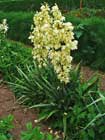 Yucca filamentosa: An evergreen shrub growing about two and a half feet tall, this hardy plant brings a sub-tropical appearance to the garden. It requires a sunny position and well drained soil. In its native habitat, the flowers of this plant can only be pollinated by a specially adapted species of insect, so to produce fruits in this country the flowers must be hand pollinated. Apart from this it is a very easy plant to grow and the fruit is said to be a date substitute - it can be eaten raw or dried for winter use. Other uses for this plant include a fibre made from the leaves used to make ropes etc, and a soap obtained by boiling the roots. The flowers, also, are said to be edible. Other members of this genus with similar uses include Y. baccata (only hardy in south west England, but the nicest fruit), Y. glauca and Y. whipplei.
Yucca filamentosa: An evergreen shrub growing about two and a half feet tall, this hardy plant brings a sub-tropical appearance to the garden. It requires a sunny position and well drained soil. In its native habitat, the flowers of this plant can only be pollinated by a specially adapted species of insect, so to produce fruits in this country the flowers must be hand pollinated. Apart from this it is a very easy plant to grow and the fruit is said to be a date substitute - it can be eaten raw or dried for winter use. Other uses for this plant include a fibre made from the leaves used to make ropes etc, and a soap obtained by boiling the roots. The flowers, also, are said to be edible. Other members of this genus with similar uses include Y. baccata (only hardy in south west England, but the nicest fruit), Y. glauca and Y. whipplei.
 Zanthoxylum piperitum - Japanese Pepper Tree: A deciduous shrub growing to about 15 feet, preferring a loamy soil but not really fussy as to soil or location. The ground-up seeds are used as a pepper substitute whilst the bark and leaves are used as a spice.
Zanthoxylum piperitum - Japanese Pepper Tree: A deciduous shrub growing to about 15 feet, preferring a loamy soil but not really fussy as to soil or location. The ground-up seeds are used as a pepper substitute whilst the bark and leaves are used as a spice.
Database
The database has more details on these plants: Amelanchier canadensis, Arbutus unedo, Berberis aggregata, Berberis angulosa, Berberis aristata, Berberis asiatica, Berberis buxifolia, Berberis lycium, Comptonia peregrina, Comptonia peregrina asplenifolia, Cornus mas, Cornus rugosa, Crataegus canadensis, Crataegus opaca, Cydonia oblonga, Diospyros lotus, Elaeagnus multiflora, Elaeagnus multiflora ovata, Laurus nobilis, Mahonia aquifolium, Morus nigra, Poncirus trifoliata, Prunus cerasifera, Prunus dulcis, Rhus aromatica, Rhus typhina, Ribes americanum, Ribes bracteosum, Ribes cereum, Ribes niveum, Ribes rotundifolium, Rosa acicularis, Rosa canina, Rosa glauca, Rosa rubiginosa, Rosa villosa, Rosa virginiana, Rubus amabilis, Rubus biflorus, Rubus canadensis, Rubus laciniatus, Rubus odoratus, Rubus parviflorus, Rubus spectabilis, Rubus tricolor, Taxus baccata, Yucca baccata, Yucca filamentosa, Yucca glauca, Yucca whipplei, Zanthoxylum piperitum.